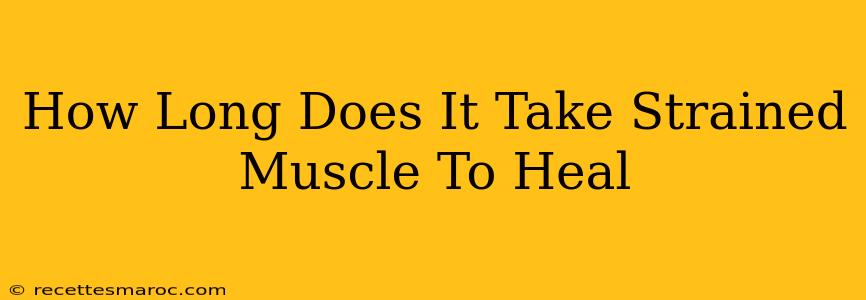A strained muscle, also known as a muscle pull, is a common injury that occurs when a muscle is overstretched or torn. The healing time for a strained muscle varies depending on the severity of the injury. Understanding the different grades of muscle strains and the healing process can help manage expectations and promote faster recovery.
Understanding Muscle Strain Grades
Muscle strains are categorized into three grades based on the severity of the damage:
Grade 1 Strain:
- Severity: Mild strain with minimal muscle fiber tearing. You might experience mild pain and tenderness, but you can still use the muscle.
- Healing Time: Typically heals within 1 to 3 weeks. Rest, ice, compression, and elevation (RICE) are usually sufficient.
Grade 2 Strain:
- Severity: Moderate strain with more significant muscle fiber tearing. You'll experience more pain, swelling, bruising, and limited range of motion. Using the muscle may be difficult or painful.
- Healing Time: Healing can take 3 to 6 weeks, possibly longer depending on the muscle involved and individual factors. Physical therapy may be needed to regain full strength and function.
Grade 3 Strain:
- Severity: Severe strain involving a complete tear of the muscle. You'll experience significant pain, swelling, bruising, and complete loss of muscle function. This often requires medical intervention.
- Healing Time: This is the most serious strain and can take 6 weeks to several months, or even longer, to heal. Surgery might be necessary in some cases, followed by extensive rehabilitation.
Factors Affecting Healing Time
Several factors can influence how long it takes a strained muscle to heal:
- Severity of the Strain: As discussed above, higher-grade strains take considerably longer to heal.
- Age: Older individuals tend to heal more slowly than younger individuals.
- Overall Health: Pre-existing conditions, such as diabetes or poor circulation, can impact healing time.
- Treatment: Following a proper treatment plan, including rest, ice, compression, elevation, and physical therapy, significantly speeds recovery.
- Individual Variation: Healing times vary from person to person. Genetic factors and individual body responses play a role.
Signs You Need Medical Attention
While many muscle strains can be treated at home, it's crucial to seek medical attention if:
- You experience severe pain.
- There's significant swelling or bruising.
- You cannot use the affected muscle.
- You hear or feel a "pop" or "snap" at the time of injury.
- You have numbness or tingling in the affected area.
- Pain persists for more than a few days despite home treatment.
Accelerating Muscle Strain Recovery
While healing time varies, you can take steps to promote faster recovery:
- RICE Method: Rest, ice, compression, and elevation help reduce swelling and pain.
- Over-the-Counter Pain Relief: Ibuprofen or naproxen can help manage pain and inflammation.
- Physical Therapy: A physical therapist can develop a personalized exercise program to restore strength and range of motion.
- Proper Nutrition: A balanced diet rich in protein supports muscle repair.
- Avoid Re-Injury: Gradually return to activity to prevent re-injury.
Conclusion
The healing time for a strained muscle is highly variable. Understanding the severity of the strain, along with the factors influencing healing, is essential for managing expectations and promoting proper recovery. While many mild strains heal within weeks, more severe strains may require medical intervention and extensive rehabilitation. Always consult with a healthcare professional if you're unsure about the severity of your injury or if pain persists.

